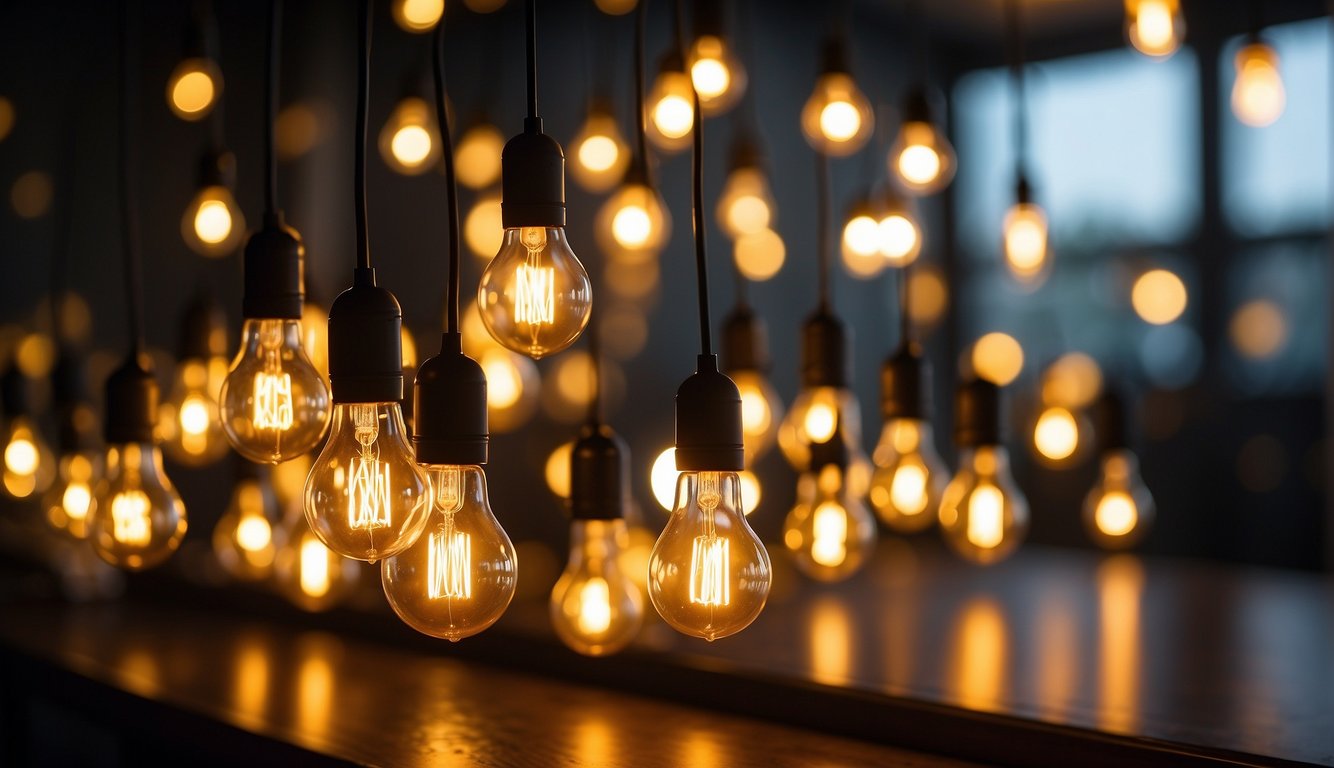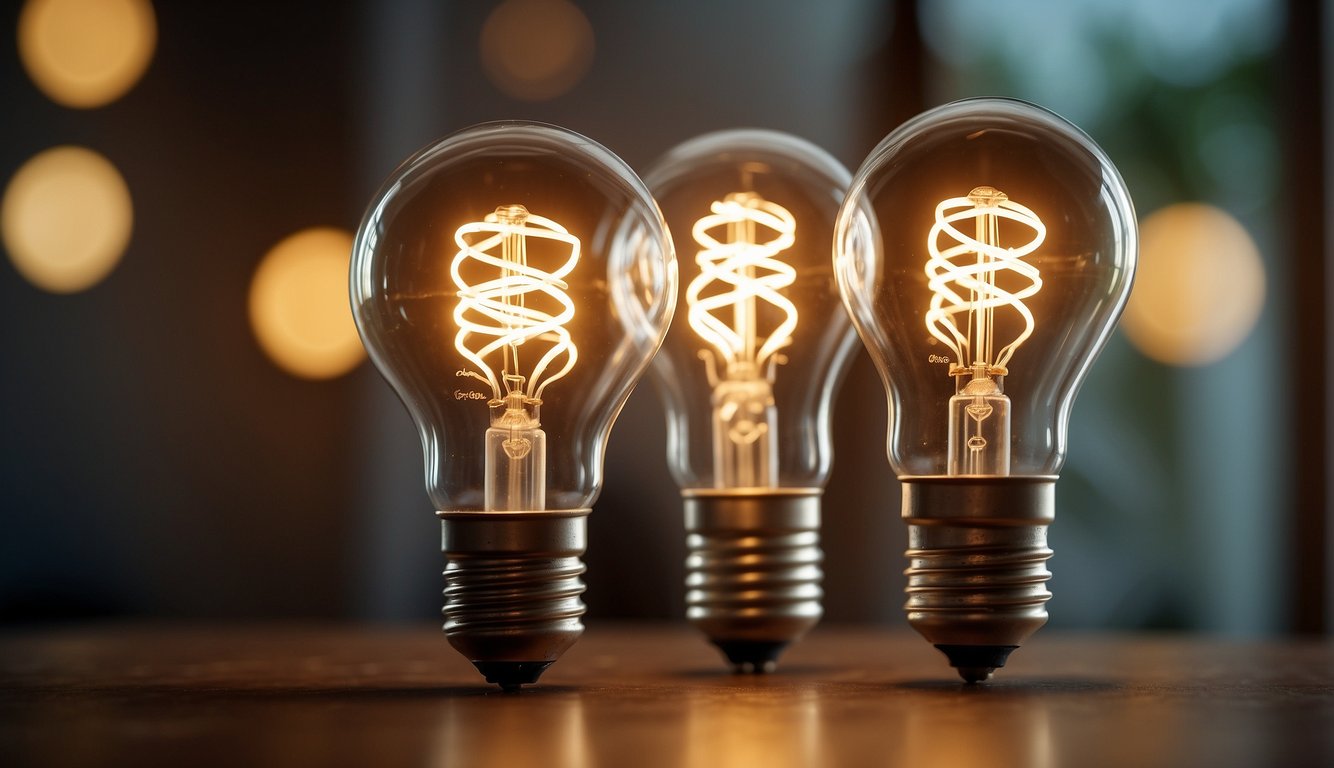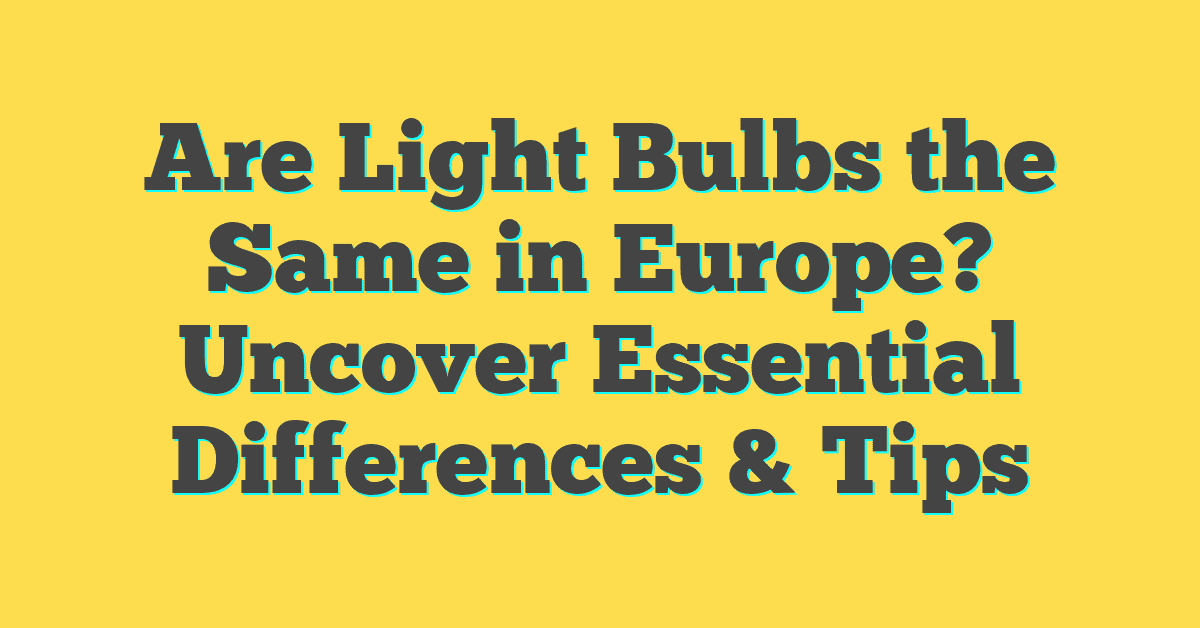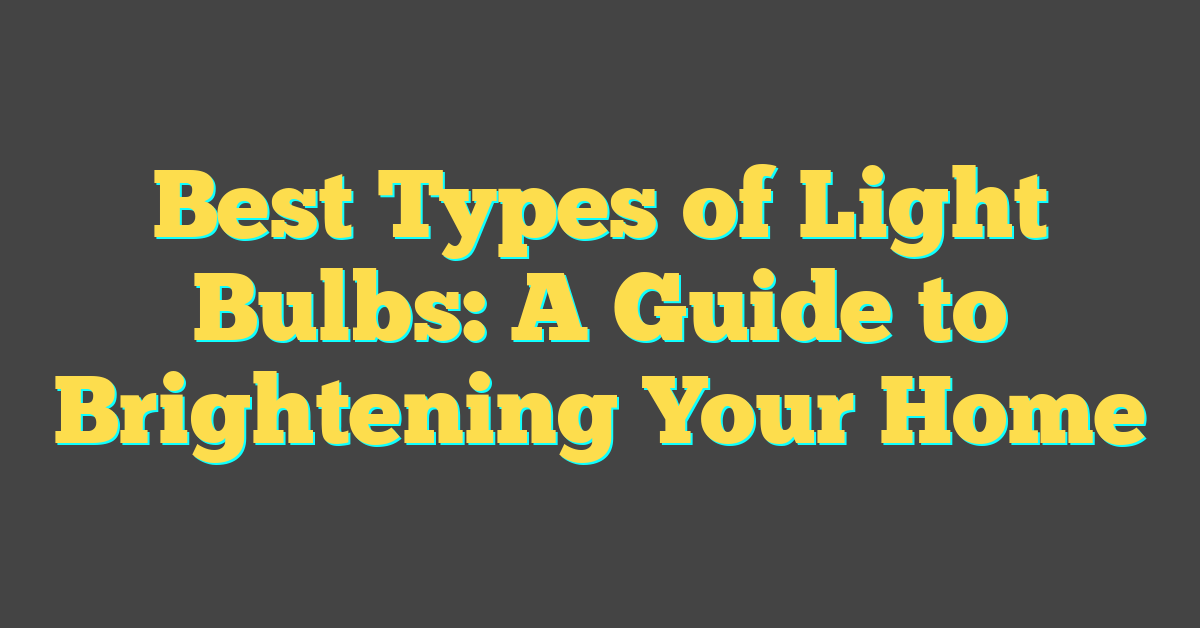The evolution of lighting technology has brought us from the warm familiar glow of incandescent bulbs to the more energy-efficient and durable LED lights. Incandescent bulbs have been a household staple since their invention, providing a soft light that many have come to associate with home lighting. However, they operate by heating a filament until it glows, which is not as energy-efficient as modern lighting options.


LED bulbs, on the other hand, create light through a semiconductor that emits photons when an electrical current passes through it. This method is significantly more energy-efficient, and the bulbs themselves tend to last much longer than their incandescent counterparts. Additionally, LED lighting can save you money on your electricity bill and reduce environmental impact, advancing the trend toward greener solutions in household and commercial settings.
Key Takeaways
- LED lights are more energy-efficient than incandescent bulbs.
- The lifespan of LED bulbs is significantly longer when compared to incandescent lighting.
- Switching to LED lighting can lead to cost savings and a lower environmental footprint.
History of Light Bulbs
The evolution of the light bulb is a fascinating journey from simple beginnings to a beacon of modern innovation. You’ll see how the quest for brightness transformed the way you light up your world.
https://www.youtube.com/watch?v=uszG5FD1_Uw&embed=true
Development of Incandescent Bulbs
The incandescent bulb is a classic icon in the history of lighting. Pioneers like Thomas Edison played a significant role in its development. Around 1879, Edison commercially introduced an incandescent bulb with a carbon filament, setting a standard for lighting that lasted for over a century. But the story doesn’t start or end with Edison alone; many scientists contributed to this history of the light bulb.
Advancements in LED Technology
Next came LEDs (Light Emitting Diodes), a leap in technology that would revolutionize lighting efficiency. Originating from the experiments of scientists like Arthur Compton, LEDs transformed from small indicator lights in the early 1960s to robust sources of light for homes and businesses today. LEDs offer longevity and energy savings that incandescents could never match, brightening your life while lowering electric bills.
The Rise of Fluorescent Lighting
Fluorescent bulbs brought about another shift in the lighting landscape. By passing electricity through mercury vapor, these tubes produced ultraviolet light, then converted it into visible light via a phosphorescent coating. First marketed in the 1930s, fluorescents became widely popular for their energy efficiency well before LEDs were a viable option for everyday use.
From Edison’s persistent tinkering to the latest LEDs and fluorescents, the bulbs lighting up your rooms have a rich and innovative heritage.
Technical Differences
https://www.youtube.com/watch?v=eJ0f_L1Kjs0&embed=true
When you’re deciding between different types of light bulbs, understanding the technical differences can help you make an informed choice. Let’s examine how these bulbs produce light and their material composition.
How Bulbs Produce Light
Incandescent Bulbs: Your traditional incandescent bulb works by passing electricity through a thin tungsten filament. The electrical resistance of the filament heats it up until it glows, producing light. However, this process isn’t very energy efficient as most of the energy is converted to heat rather than visible light.
LED Bulbs: On the other hand, LED bulbs, which stands for light-emitting diode, produce light through a completely different mechanism. When electricity passes through a semiconductor, which in the case of an LED is a diode, it emits photons (light), in a process known as electroluminescence. LEDs need much less electricity to produce the same amount of light, making them significantly more energy efficient.
Materials and Construction
Incandescent Bulbs Construction:
- Glass bulb: Encases the filament and inert gases like argon.
- Filament: Usually made of tungsten, it glows when heated.
- Contact wire: Connects to the electrical circuit.
Incandescent bulbs have a simple design but have a shorter lifespan due to the filament eventually burning out.
« Simple Guide to Light Bulbs: Choosing the Right One for Your Home
Recommended Light Bulbs for Bathrooms: Brightness & Durability Guide »
LED Bulbs Construction:
- Semiconductor material: Acts as the diode, typically made of various compounds.
- Heat sink: Helps to dissipate heat and keep the LED cool.
- Lensing: Controls beam direction and light spread.
LED bulbs are more complex in design, and their construction doesn’t involve harmful materials like mercury, unlike CFL bulbs (Compact Fluorescent Lamps). The use of a heat sink is crucial as it extends the life of the bulb by preventing overheating.
Remember that by choosing LEDs, you’re opting for bulbs that are longer-lasting and more energy-efficient.
Energy Efficiency and Consumption
https://www.youtube.com/watch?v=CL2f9f80-RY&embed=true
When you’re looking to reduce your home’s energy consumption, understanding the relationship between energy efficiency and lighting is crucial. Switching to energy-efficient bulbs can significantly lower electricity use and costs associated with lighting your home.
Wattage and Lumens Comparison
To start, let’s compare two key terms:
- Watts (W) measure how much energy a bulb consumes.
- Lumens (lm) measure the amount of light a bulb emits.
Here’s a stark difference: an LED light bulb uses up to 90% less energy while lasting up to 25 times longer than traditional incandescent bulbs. To put this into perspective:
| Bulb Type | Energy Used | Brightness |
|---|---|---|
| Incandescent | ~60W | ~800 lm |
| LED | ~10W | ~800 lm |
You’ll find that an LED bulb provides the same brightness for a fraction of the wattage.
Impact on Electricity Costs
Your lighting choices directly influence your electricity bill. By opting for bulbs that have the ENERGY STAR certification, you’re ensuring that the product meets strict energy efficiency guidelines set by the U.S. Environmental Protection Agency.
- An incandescent bulb could cost about $4.80 per year to operate
- In contrast, an ENERGY STAR-rated LED might cost only $1.00 per year
By updating to energy-efficient lighting, you could save approximately $225 annually on energy bills, as estimated by the Department of Energy. Remember, when you reduce energy consumption, you’re not only saving money but also helping the environment by lowering greenhouse gas emissions.
Economic Aspects

When it comes to light bulbs, your decisions have financial implications both at the time of purchase and over the lifespan of the product. The type of bulb you choose can affect your wallet in different ways, from initial outlay to ongoing energy costs.
Initial Purchase Price
Incandescent bulbs are often less expensive when you’re standing in the store comparing price tags. Typically, you’ll spend less money upfront when buying traditional incandescent bulbs compared to their energy-efficient counterparts like LEDs or CFLs. However, this is only part of the economic picture.
Long-Term Savings
The real savings begin to shine over time. Energy-efficient bulbs may have a higher upfront cost, but they tend to last significantly longer than traditional incandescent bulbs. This means you’ll buy and replace them less often, saving on replacement costs.
Additionally, bulbs like LEDs use substantially less electricity—LED lights can use up to 90% less energy, to be more precise. This could translate to noticeable savings on your energy bill. When you multiply this by the number of bulbs in your home, the amount of money you save over time can be quite substantial. The lower energy use also results in lower greenhouse gas emissions, which positively impacts the environment.
Moreover, the lifetime cost of a light bulb is not just about the number of bulbs you buy but also the amount of electricity they use. So while the sticker price is higher, energy-efficient bulbs end up being less expensive over their lifetime, giving you significant long-term savings.
Environmental Impact
https://www.youtube.com/watch?v=pZCqagCHd3s&embed=true
When you switch from incandescent light bulbs to more energy-efficient alternatives, you make a significant positive impact on the environment. Your choices aid in reducing energy use and curbing waste and pollution.
Reduction in Energy Use
Incandescent bulbs convert only about 2-3% of the electricity they consume into visible light. The rest is lost as heat. In contrast, energy-saving bulbs like LEDs are much more efficient, with a significant percentage of energy going directly to light production. This means that for each incandescent bulb replaced with an LED, you contribute to substantial energy savings, which can lead to reduced demand for electricity and lower greenhouse gas emissions.
Waste and Pollution
The longer lifespan of energy-efficient bulbs means fewer units end up in the waste stream. Incandescent bulbs, by contrast, have a shorter lifespan and contribute to higher waste volumes. Additionally, traditional incandescent bulbs do not contain mercury vapor, which is a relief as they will not release harmful substances into the environment when broken or disposed of. However, some energy-saving bulbs, like compact fluorescents, do contain mercury, necessitating careful disposal to avoid pollution. Choosing LEDs, which don’t contain mercury, can help reduce this type of environmental risk.
Light Quality and Comfort
https://www.youtube.com/watch?v=XeR2uPPCA2k&embed=true
When considering the comfort and atmosphere in your space, the light quality of your bulbs plays a significant role. You’ll find that factors like color temperature, glare, and light distribution greatly affect the general ambiance and can either enhance or detract from your comfort.
Color Temperature and Ambiance
The color temperature of a bulb greatly influences the feel of your room. Incandescent bulbs are known for their warm, soft glow, creating a relaxing ambiance that’s often described as inviting. This is measured in Kelvins, and incandescent bulbs typically have a lower Kelvin rating, denoting a warmer, orange-tinted light. On the other hand, LEDs have a broader spectrum, ranging from warm to cool light, thus you can choose a light that suits the comfort you’re aiming for. The color rendering index (CRI) of a bulb denotes how well the light portrays colors realistically; incandescent generally have a high CRI, which can make your surroundings feel more natural and inviting.
Glare and Light Distribution
The distribution of light affects how comfortable you are while reading or gathering with friends. Incandescent bulbs emit light in all directions, which can lead to less glare and a more evenly distributed light that’s softer on the eyes. LEDs have improved in this area, with many options designed to emulate the light distribution of incandescent bulbs, making them suitable for a home environment where avoiding harsh lighting is essential for creating a welcoming space. Good light distribution helps reduce shadowing and provides consistent illumination across your entire space.
Lifespan and Durability
https://www.youtube.com/watch?v=yM_E0mHi9Wg&embed=true
When choosing light bulbs, you’re likely looking for options that won’t have you climbing a ladder to replace them frequently. Lifespan and durability are critical factors, with maintenance and replacement needs weighing heavily on the decision.
Average Lifespans of Bulbs
The average lifespan of a light bulb is a key metric to consider. LED bulbs stand out, lasting for about 25,000 to 50,000 hours, showcasing a remarkable increase in longevity compared to traditional bulbs. On the other end of the spectrum, standard incandescent bulbs typically provide around 1,000 hours of light. This information on the lifespan of bulbs shows clear differences, helping you to understand what to expect from each type.
Maintenance and Replacement
The long-term durability of your light bulbs can affect how often you’ll need to perform maintenance or replacement. With incandescent bulbs, the need for replacement is more frequent due to their shorter rated life. The lower heat emission from LED bulbs benefits their longevity and can reduce the risk associated with high temperatures, therefore requiring less maintenance. LED bulbs’ impact on safety and maintenance is undoubtedly a consideration for your choice.
Health and Safety Considerations
https://www.youtube.com/watch?v=I_3b4cgAczQ&embed=true
When you’re deciding on lighting options, it’s important to weigh health and safety considerations carefully. Incandescent bulbs differ from modern lighting technologies in a few key aspects, such as their mercury content and the amount of heat they emit.
Mercury Content and Risks
Mercury Content: Unlike some energy-saving bulbs, such as compact fluorescent lamps (CFLs), incandescent bulbs do not contain mercury, which can be a relief if you’re concerned about the potential health risks and environmental impact associated with mercury. Mercury exposure can be hazardous, and safe disposal of bulbs containing mercury is critical to avoiding environmental contamination.
Heat Emission and Burn Risk
Heat Emission: Incandescent bulbs convert a larger portion of energy into heat rather than light, often becoming hot to the touch. This can pose a burn risk, especially if you’re replacing a bulb shortly after use or if the bulb is within reach of children.
- Safety Tip: Always allow bulbs to cool down before handling to reduce the risk of burns.
In terms of ultraviolet light, incandescent bulbs emit very low levels compared to some other types of bulbs, which can be an advantage if you’re concerned about UV exposure. But remember, lower heat emission in lighting is generally better for both safety and energy conservation.
Compatibility and Usage
https://www.youtube.com/watch?v=cQwxU1syGzk&embed=true
When you’re deciding between lighting options, think about both where they’ll be used—like your home or business—and how they’ll fit with your current technology, such as smart home systems.
Suitability for Home and Business
For your home, LED bulbs are a go-to for versatility and long-term savings. They work well in a range of appliances, and many options are available with dimming capabilities to suit your mood and save energy. On the other hand, businesses benefit from LEDs due to their long lifespan and energy efficiency, making them a cost-effective solution for places that keep lights on for extended periods. Some LEDs have been specifically designed for commercial settings, providing powerful lighting that’s still cost-effective.
Integration with Smart Technology
Smart home technology and LEDs are like close friends; they just click. Most LED bulbs easily integrate with smart home systems, which means you can control brightness, switch lights on or off, and even change colors using your smartphone or voice commands. This functionality extends to both home and business environments, offering convenience and enhanced control that traditional incandescent bulbs simply can’t provide. Whether you’re automating your living room or setting the scene in a customer-facing business, smart LEDs are up for the task.
Future Trends in Lighting
https://www.youtube.com/watch?v=KQnLpAAWk-M&embed=true
As you continue to light up your life, you’ll see LED technology and smart lighting systems becoming ever more central in the marketplace, driven by energy efficiency goals and regulatory changes.
Innovations in LED and Smart Bulbs
LED (light-emitting diode) technology has revolutionized lighting, providing options that are significantly more energy-efficient than traditional incandescent bulbs. The future of LED lighting is not just about improving efficiency but also about enhancing experience and functionality. Manufacturers are experimenting with advanced semiconductor materials that could allow LEDs to deliver better color accuracy and increased brightness without sacrificing longevity.
Smart bulbs take LED innovation a step further, integrating features like color changing, scheduling, and remote controlling through apps. In the near future, you can expect smarter, more intuitive systems that can learn from your habits and even communicate with other smart home devices for a truly automated home environment.
Regulations and Market Shift
The lighting industry is undergoing a shift, partly due to regulations imposed by entities like the U.S. Department of Energy which aim to phase out less efficient incandescent bulbs. This aligns with the global push toward NOPEC (Non-Oil Producing and Exporting Countries) standards, focusing on energy conservation and reduced carbon footprint in lighting products.
As a result, you’ll see a push toward energy-efficient lighting solutions that not only help reduce electricity bills but also aim to minimize the environmental impact. MessageLookupating market trends suggest a gradual shift from old lighting technologies to newer, greener solutions that align with upcoming regulatory expectations and consumer preferences.




